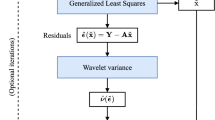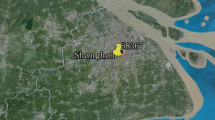Abstract
This study explores methods with which multidimensional data, e.g. time series, can be effectively incorporated into a Bayesian framework for inferring geostatistical parameters. Such series are difficult to use directly in the likelihood estimation procedure due to their high dimensionality; thus, a dimension reduction approach is taken to utilize these measurements in the inference. Two synthetic scenarios from hydrology are explored in which pumping drawdown and concentration breakthrough curves are used to infer the global mean of a log-normally distributed hydraulic conductivity field. Both cases pursue the use of a parametric model to represent the shape of the observed time series with physically-interpretable parameters (e.g. the time and magnitude of a concentration peak), which is compared to subsets of the observations with similar dimensionality. The results from both scenarios highlight the effectiveness for the shape-matching models to reduce dimensionality from 100+ dimensions down to less than five. The models outperform the alternative subset method, especially when the observations are noisy. This approach to incorporating time series observations in the Bayesian framework for inferring geostatistical parameters allows for high-dimensional observations to be faithfully represented in lower-dimensional space for the non-parametric likelihood estimation procedure, which increases the applicability of the framework to more observation types. Although the scenarios are both from hydrogeology, the methodology is general in that no assumptions are made about the subject domain. Any application that requires the inference of geostatistical parameters using series in either time of space can use the approach described in this paper.
















Similar content being viewed by others
References
Bellman RE (1961) Adaptive control processes: a guided tour. Princeton University Press, Princeton
Berkowitz B, Klafter J, Metzler R, Scher H (2002) Physical pictures of transport in heterogeneous media: advection-dispersion, random-walk, and fractional derivative formulations. Water Resour Res 38(10):9-1–9-12. https://doi.org/10.1029/2001WR001030
Carrera J, Alcolea A, Medina A, Hidalgo J, Slooten LJ (2005) Inverse problem in hydrogeology. Hydrogeol J 13(1):206–222. https://doi.org/10.1007/s10040-004-0404-7
Chen X, Murakami H, Hahn MS, Hammond GE, Rockhold ML, Zachara JM, Rubin Y (2012) Three-dimensional Bayesian geostatistical aquifer characterization at the Hanford 300 Area using tracer test data. Water Resour Res 48(6):W06501. https://doi.org/10.1029/2011WR010675
Cirpka OA, Kitanidis PK (2000) Characterization of mixing and dilution in heterogeneous aquifers by means of local temporal moments. Water Resour Res 36(5):1221–1236. https://doi.org/10.1029/1999WR900354
Copty NK, Trinchero P, Sanchez-Vila X (2011) Inferring spatial distribution of the radially integrated transmissivity from pumping tests in heterogeneous confined aquifers. Water Resour Res. https://doi.org/10.1029/2010WR009877
Ebrahimi N, Soofi ES, Soyer R (2010) Information measures in perspective. Int Stat Rev 78(3):383–412. https://doi.org/10.1111/j.1751-5823.2010.00105.x
Firmani G, Fiori A, Bellin A (2006) Three-dimensional numerical analysis of steady state pumping tests in heterogeneous confined aquifers. Water Resour Res. https://doi.org/10.1029/2005WR004382
Gelfand AE (2012) Hierarchical modeling for spatial data problems. Spat Stat 1(Suppl C):30–39. https://doi.org/10.1016/j.spasta.2012.02.005
Gelfand AE, Schliep EM (2016) Spatial statistics and Gaussian processes: a beautiful marriage. Spat Stat 18(A):86–104. https://doi.org/10.1016/j.spasta.2016.03.006
Gelhar L (1993) Stochastic subsurface hydrology. Prentice-Hall, Engelwood Cliffs
Ginn TR (2004) On the application of stochastic approaches in hydrogeology. Stoch Environ Res Risk Assess (SERRA) 18(4):282–284. https://doi.org/10.1007/s00477-004-0199-z
Gómez-Hernández JJ, Wen XH (1998) To be or not to be multi-gaussian? A reflection on stochastic hydrogeology. Adv Water Resour 21(1):47–61. https://doi.org/10.1016/S0309-1708(96)00031-0
Harp DR, Vesselinov VV (2010) Stochastic inverse method for estimation of geostatistical representation of hydrogeologic stratigraphy using borehole logs and pressure observations. Stoch Environ Res Risk Assess 24:1023–1042. https://doi.org/10.1029/2008GL033585
Hayfield T, Racine JS (2008) Nonparametric econometrics: the np package. J Stat Softw 27(5):1–32. https://doi.org/10.1198/jasa.2001.s374
Hernandez AF, Neuman SP, Guadagnini A, Carrera J (2003) Conditioning mean study state flow on hydraulic head and conductivity through geostatistical inversion. Stoch Environ Res Risk Assess 17(5):329–338. https://doi.org/10.1007/s00477-003-0154-4
Heße F, Savoy H, Osorio-Murillo CA, Sege J, Attinger S, Rubin Y (2015) Characterizing the impact of roughness and connectivity features of aquifer conductivity using Bayesian inversion (Groundwater flow and transport in aquifers: insights from modeling and characterization at the field scale). J Hydrol 531(Part 1):73–87. https://doi.org/10.1016/j.jhydrol.2015.09.067
Indelman P, Fiori A, Dagan G (1996) Steady flow toward wells in heterogeneous formations: mean head and equivalent conductivity. Water Resour Res 32(7):1975–1983. https://doi.org/10.1029/96WR00990
Jose SC, Cirpka OA (2004) Measurement of mixing-controlled reative transport in homogeneous porous media and its prediction from conservative tracer test data. Environ Sci Technol 38:2089–2096. https://doi.org/10.1021/es034586b
Kolditz O, Bauer S, Bilke L, Böttcher N, Delfs JO, Fischer T, Görke UJ, Kalbacher T, Kosakowski G, McDermott I, Park CH, Radu FA, Rink K, Shao H, Shao H, Sun F, Sun YY, Singh AK, Taron J, Walther M, Wang W, Watanabe N, Wu Y, Xie M, Xu W, Zehner B (2012) Opengeosys: an open-source initiative for numerical simulation of thermo-hydro-mechanical/chemical (THM/C) processes in porous media. Environ Earth Sci 67(2):589–599. https://doi.org/10.1007/s12665-012-1546-x
Lan K, Jorgenson JW (2001) A hybrid of exponential and Gaussian functions as a simple model of asymmetric chromatographic peaks. J Chromatogr A 915:1–13. https://doi.org/10.1016/S0021-9673(01)00594-5
Li Q, Racine J (2003) Nonparametric estimation of distributions with categorical and continuous data. J Multivar Anal 86(2):266–292. https://doi.org/10.1016/S0047-259X(02)00025-8
Linde N, Renard P, Mukerji T, Caers J (2015) Geological realism in hydrogeological and geophysical inverse modeling: a review. Adv Water Resour 86(Part A):86–101. https://doi.org/10.1016/j.advwatres.2015.09.019
Lourens A, van Geer FC (2016) Uncertainty propagation of arbitrary probability density functions applied to upscaling of transmissivities. Stoch Environ Res Risk Assess 30(1):237–249. https://doi.org/10.1007/s00477-015-1075-8
Mara TA, Fajraoui N, Guadagnini A, Younes A (2017) Dimensionality reduction for efficient Bayesian estimation of groundwater flow in strongly heterogeneous aquifers. Stoch Environ Res Risk Assess 31(9):2313–2326. https://doi.org/10.1007/s00477-016-1344-1
Murakami H, Chen X, Hahn MS, Liu Y, Rockhold ML, Vermeul VR, Zachara JM, Rubin Y (2010) Bayesian approach for three-dimensional aquifer characterization at the Hanford 300 Area. Hydrol Earth Syst Sci 14(10):1989–2001. https://doi.org/10.5194/hess-14-1989-2010
Neuman S, Di Federico V (2003) Multifaceted nature of hydrogeologic scaling and its interpretation. Rev Geophys. https://doi.org/10.1029/2003RG000130
Neuman SP, Tartakovsky DM (2009) Perspective on theories of non-fickian transport in heterogeneous media. Adv Water Resour 32(5):670–680. https://doi.org/10.1016/j.advwatres.2008.08.005
Neuman SP, Guadagnini A, Riva M (2004) Type-curve estimation of statistical heterogeneity. Water Resour Res 40(4):1–7. https://doi.org/10.1029/2003WR002405
Neuman SP, Blattstein A, Riva M, Tartakovsky DM, Guadagnini A, Ptak T (2007) Type curve interpretation of late-time pumping test data in randomly heterogeneous aquifers. Water Resour Res. https://doi.org/10.1029/2007WR005871
Osorio-Murillo CA, Over MW, Savoy H, Ames DP, Rubin Y (2015) Software framework for inverse modeling and uncertainty characterization. Environ Model Softw 66:98–109. https://doi.org/10.1016/j.envsoft.2015.01.002
Pechstein A, Attinger S, Krieg R, Copty NK (2016) Estimating transmissivity from single-well pumping tests in heterogeneous aquifers. Water Resour Res 52(1):495–510. https://doi.org/10.1002/2015WR017845
Piantadosi ST (2018) One parameter is always enough, pp 1–6. https://colala.bcs.rochester.edu/papers/piantadosi2018one.pdf. Accessed 16 Sept 2018
Riva M, Guadagnini A, Bodin J, Delay F (2009a) Characterization of the hydrogeological experimental site of Poitiers (France) by stochastic well testing analysis. J Hydrol 369(1–2):154–164. https://doi.org/10.1016/j.jhydrol.2009.02.040
Riva M, Guadagnini A, Neuman SP, Janetti EB, Malama B (2009b) Inverse analysis of stochastic moment equations for transient flow in randomly heterogeneous media. Adv Water Resour 32(10):1495–1507. https://doi.org/10.1016/j.advwatres.2009.07.003
Riva M, Panzeri M, Guadagnini A, Neuman SP (2011) Role of model selection criteria in geostatistical inverse estimation of statistical data- and model-parameters. Water Resour Res. https://doi.org/10.1029/2011WR010480
Rubin Y (2003) Applied stochastic hydrogeology. Oxford University Press, Oxford
Rubin Y (2004) Stochastic hydrogeology—challenges and misconceptions. Stoch Environ Res Risk Assess 18(4):280–281. https://doi.org/10.1007/s00477-004-0193-5
Rubin Y, Dagan G (1987) Stochastic identification of transmissivity and effective recharge in steady groundwater flow: 1. Theory. Water Resour Res 23(7):1185–1192. https://doi.org/10.1029/WR023i007p01185
Rubin Y, Chen X, Murakami H, Hahn M (2010) A Bayesian approach for inverse modeling, data assimilation, and conditional simulation of spatial random fields. Water Resour Res. https://doi.org/10.1029/2009WR008799
Sánchez-Vila X, Meier PM, Carrera J (1999) Pumping tests in heterogeneous aquifers: an analytical study of what can be obtained from their interpretation using Jacob’s method. Water Resour Res 35(4):943–952. https://doi.org/10.1029/1999WR900007
Savoy H, Heße F, Rubin Y (2017) anchoredDistr: a package for the Bayesian inversion of geostatistical parameters with multi-type and multi-scale data. R J 9(2):6–17
Scott DW (1992) Multivariate density estimation: theory, practice, and visualization. Wiley, Hoboken
Tikhonov AN (1963a) Regularization of incorrectly posed problems. Sov Math Dokl 4:1624–1627
Tikhonov AN (1963b) Solution of incorrectly formulated problems and the regularization method. Sov Math Dokl 4:1035–1038
Tsang Y, Tsang C, Hale F, Dverstorp B (1996) Tracer transport in a stochastic continuum model of fractured media. Water Resour Res 32(10):3077–3092. https://doi.org/10.1029/96WR01397
Vogler D, Ostvar S, Paustian R, Wood BD (2018) A hierarchy of models for simulating experimental results from a 3d heterogeneous porous medium. Adv Water Resour 114:149–163. https://doi.org/10.1016/j.advwatres.2018.02.009
Vrugt JA, ter Braak CJF, Diks CGH, Robinson BA, Hyman JM, Higdon D (2009) Accelerating Markov chain Monte Carlo simulation by differential evolution with self-adaptive randomized subspace sampling. Int J Nonlinear Sci Numer Simul 10(3):273–290. https://doi.org/10.1515/IJNSNS.2009.10.3.273
Xavier S, Alberto G, Jesus C (2006) Representative hydraulic conductivities in saturated groundwater flow. Rev Geophys. https://doi.org/10.1029/2005RG000169
Zech A, Müller S, Mai J, Heße F, Attinger S (2016) Extending theis’ solution: using transient pumping tests to estimate parameters of aquifer heterogeneity. Water Resour Res 52(8):6156–6170. https://doi.org/10.1002/2015WR018509
Zhou H, Gómez-Hernández JJ, Li L (2014) Inverse methods in hydrogeology: evolution and recent trends. Adv Water Resour 63:22–37. https://doi.org/10.1016/j.advwatres.2013.10.014
Zinn B, Harvey CF (2003) When good statistical models of aquifer heterogeneity go bad: a comparison of flow, dispersion, and mass transfer in connected and multivariate Gaussian hydraulic conductivity fields. Water Resour Res. https://doi.org/10.1029/2001WR001146
Acknowledgements
This work was supported by the National Science Foundation under Grant EAR-1011336, “The Method of Anchored Distributions (MAD): Principles and Implementation as a Community Resource.” Any opinions, findings and conclusions or recommendations expressed in this material are those of the authors and do not necessarily reflect the views of the National Science Foundation. This research also used resources of the National Energy Research Scientific Computing Center, a DOE Office of Science User Facility supported by the Office of Science of the U.S. Department of Energy under Contract No. DE-AC02-05CH11231. We thank Yoram Rubin (University of California, Berkeley) for his constructive comments during the planning of this study. We are also grateful for the constructive comments from our two anonymous reviewers.
Author information
Authors and Affiliations
Corresponding author
Additional information
Publisher's Note
Springer Nature remains neutral with regard to jurisdictional claims in published maps and institutional affiliations.
Rights and permissions
About this article
Cite this article
Savoy, H., Heße, F. Dimension reduction for integrating data series in Bayesian inversion of geostatistical models. Stoch Environ Res Risk Assess 33, 1327–1344 (2019). https://doi.org/10.1007/s00477-019-01697-9
Published:
Issue Date:
DOI: https://doi.org/10.1007/s00477-019-01697-9




